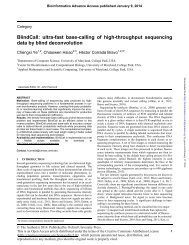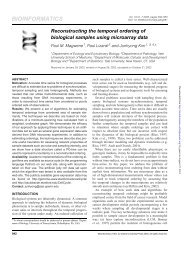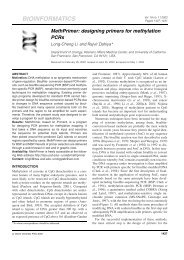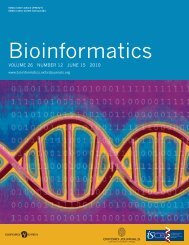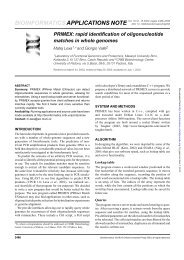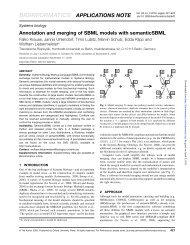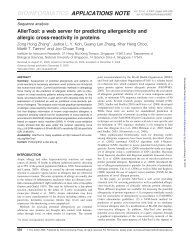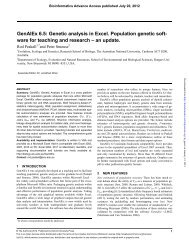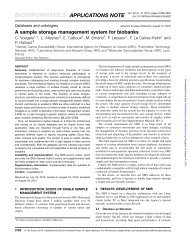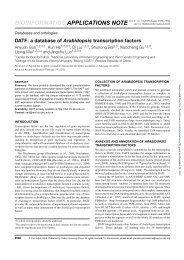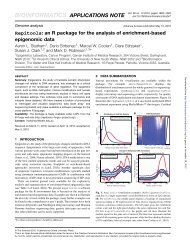Substring selection for biomedical document classification
Substring selection for biomedical document classification
Substring selection for biomedical document classification
You also want an ePaper? Increase the reach of your titles
YUMPU automatically turns print PDFs into web optimized ePapers that Google loves.
Table 1. Summary of the five PTM datasets<br />
PTM types Positives Negatives<br />
Acetylation 55 868<br />
Glycosylation 41 711<br />
Hydroxylation 27 133<br />
Methylation 27 171<br />
Phosphorylation 79 389<br />
‘ ’ were mapped to spacer symbol B. A total of 524 common words<br />
(e.g. ‘and’, ‘of’, etc.) were removed from the <strong>document</strong>s.<br />
3.2 Experimental setup<br />
For each of the five datasets from Table 1, we per<strong>for</strong>med eight<br />
groups of experiments on each combination from (Word-Based,<br />
<strong>Substring</strong>-Based attribute extraction) · (SVM, Naive Bayes classifier)<br />
· (IG, WRST attribute <strong>selection</strong>). For each choice, we estimated<br />
AUC, TOP10 and FP80 accuracies using cross-validation. The<br />
procedure consisted of splitting the labeled <strong>document</strong>s randomly<br />
into K ¼ 5 equal subsets. One of the subsets was used <strong>for</strong> accuracy<br />
testing while the remaining ones were used <strong>for</strong> training. The process<br />
was repeated K ¼ 5 times, each time using a different subset <strong>for</strong><br />
testing. The whole 5-cross-validation procedure was repeated 20<br />
times, each time using different initial split of the labeled abstracts<br />
into K subsets. The average accuracy over the 100 experiments was<br />
reported as the accuracy estimate.<br />
While application of the Naive Bayes classifiers was straight<strong>for</strong>ward,<br />
use of SVMs required appropriate data preprocessing<br />
and parameter <strong>selection</strong>. For our experiments, we used Spider<br />
SVM software (http://www.kyb.tuebingen.mpg.de/bs/people/<br />
spider/) that runs SVMLight (Joachims, 1999) in the background.<br />
Be<strong>for</strong>e training, each attribute was scaled to range [0,1]. Since our<br />
datasets were highly imbalanced, we explored several values of<br />
the balanced_ridge parameter r, which modifies kernel matrices<br />
by balancing influence of positive and negative examples. It adds<br />
r·N + /(N + + N ) to positive examples at the diagonal of the kernel<br />
matrix and r·N /(N + + N ) to the negative examples, where N + is the<br />
number of positives, and N is the number of negatives. We<br />
explored a range of r values between 2 8 and 2 8 , and determined<br />
that r ¼ 10 4 works well on all five subsets. The default SVMLight<br />
value <strong>for</strong> the slack variable was used in all experiments.<br />
3.3 Accuracy comparison<br />
In Table 2 we show the comparison between eight different ranking<br />
algorithms. The first two (WB-NB-IG and WB-SVM-IG) used<br />
Word-Based (WB) attribute extraction and In<strong>for</strong>mation Gain<br />
(IG) attribute <strong>selection</strong>. SVM denotes SVMs and NB Naive<br />
Bayes ranking algorithm. The second two (WB-NB-WRST and<br />
WB-SVM-WRST) used Word-Based attribute extraction and<br />
Wilcoxon test (WRST) attribute <strong>selection</strong>. The third two (SB-<br />
NB-IG and SB-SVM-IG) used <strong>Substring</strong>-Based (SB) attribute<br />
extraction and In<strong>for</strong>mation Gain attribute <strong>selection</strong>. The final two<br />
(SB-NB-WRST and SB-SVM-WRST) used <strong>Substring</strong>-Based<br />
attribute extraction and Wilcoxon test attribute <strong>selection</strong>.<br />
For SB algorithms, our experiments revealed that the accuracy<br />
was the highest <strong>for</strong> the correlation threshold T ¼ 0.99, that it was<br />
<strong>Substring</strong> <strong>selection</strong> <strong>for</strong> <strong>biomedical</strong> <strong>document</strong> <strong>classification</strong><br />
Table 2. Accuracies of Word-based and <strong>Substring</strong>-based classifiers (WB,<br />
Word-Based; SB, <strong>Substring</strong>-Based; NB, Naive Bayes; SVM, support vector<br />
machines; IG, in<strong>for</strong>mation gain; WRST, Wilcoxon test)<br />
Method FP80 AUC TOP10<br />
(a)Acetylation group<br />
WB-NB-IG 0.237 ± 0.018 0.855 ± 0.005 3.00 ± 0.38<br />
WB-SVM-IG 0.200 ± 0.031 0.869 ± 0.035 3.20 ± 0.39<br />
WB-NB-WRST 0.236 ± 0.010 0.854 ± 0.013 3.02 ± 0.40<br />
WB-SVM-WRST 0.239 ± 0.028 0.851 ± 0.030 2.98 ± 0.31<br />
SB-NB-IG 0.229 ± 0.009 0.864 ± 0.007 3.08 ± 0.36<br />
SB-SVM-IG 0.168 ± 0.022 0.882 ± 0.014 4.16 ± 0.17<br />
SB-NB-WRST 0.146 ± 0.010 0.916 ± 0.007 4.64 ± 0.33<br />
SB-SVM-WRST 0.171 ± 0.024 0.893 ± 0.013 4.60 ± 0.30<br />
(b) Glycosylation group<br />
WB-NB-IG 0.152 ± 0.032 0.924 ± 0.006 5.20 ± 0.30<br />
WB-SVM-IG 0.176 ± 0.039 0.883 ± 0.009 4.56 ± 0.37<br />
WB-NB-WRST 0.121 ± 0.026 0.926 ± 0.005 5.36 ± 0.27<br />
WB-SVM-WRST 0.153 ± 0.038 0.890 ± 0.008 4.64 ± 0.29<br />
SB-NB-IG 0.052 ± 0.002 0.953 ± 0.004 5.80 ± 0.24<br />
SB-SVM-IG 0.118 ± 0.055 0.926 ± 0.022 5.40 ± 0.22<br />
SB-NB-WRST 0.035 ± 0.007 0.968 ± 0.004 6.28 ± 0.18<br />
SB-SVM-WRST 0.106 ± 0.076 0.929 ± 0.017 5.40 ± 0.37<br />
(c) Hydroxylation group<br />
WB-NB-IG 0.158 ± 0.041 0.888 ± 0.012 3.96 ± 0.36<br />
WB-SVM-IG 0.286 ± 0.095 0.803 ± 0.034 3.80 ± 0.54<br />
WB-NB-WRST 0.202 ± 0.032 0.858 ± 0.018 3.86 ± 0.32<br />
WB-SVM-WRST 0.325 ± 0.091 0.795 ± 0.039 3.78 ± 0.46<br />
SB-NB-IG 0.165 ± 0.015 0.911 ± 0.003 4.44 ± 0.14<br />
SB-SVM-IG 0.233 ± 0.031 0.870 ± 0.029 4.40 ± 0.20<br />
SB-NB-WRST 0.083 ± 0.010 0.948 ± 0.004 4.76 ± 0.09<br />
SB-SVM-WRST 0.173 ± 0.042 0.872 ± 0.025 4.50 ± 0.22<br />
(d) Methylation group<br />
WB-NB-IG 0.244 ± 0.040 0.866 ± 0.015 3.88 ± 0.23<br />
WB-SVM-IG 0.209 ± 0.026 0.854 ± 0.020 3.60 ± 0.36<br />
WB-NB-WRST 0.225 ± 0.028 0.880 ± 0.014 3.94 ± 0.26<br />
WB-SVM-WRST 0.202 ± 0.022 0.864 ± 0.015 3.78 ± 0.38<br />
SB-NB-IG 0.167 ± 0.038 0.916 ± 0.015 4.40 ± 0.19<br />
SB-SVM-IG 0.208 ± 0.040 0.863 ± 0.027 4.20 ± 0.32<br />
SB-NB-WRST 0.089 ± 0.010 0.940 ± 0.005 4.60 ± 0.25<br />
SB-SVM-WRST 0.196 ± 0.041 0.879 ± 0.029 4.40 ± 0.17<br />
(e) Phosphorylation group<br />
WB-NB-IG 0.220 ± 0.006 0.895 ± 0.008 6.16 ± 0.18<br />
WB-SVM-IG 0.103 ± 0.011 0.896 ± 0.008 6.20 ± 0.20<br />
WB-NB-WRST 0.215 ± 0.009 0.895 ± 0.011 6.20 ± 0.10<br />
WB-SVM-WRST 0.130 ± 0.012 0.898 ± 0.013 6.24 ± 0.22<br />
SB-NB-IG 0.096 ± 0.005 0.917 ± 0.003 6.48 ± 0.26<br />
SB-SVM-IG 0.152 ± 0.040 0.909 ± 0.016 6.56 ± 0.28<br />
SB-NB-WRST 0.088 ± 0.005 0.925 ± 0.002 6.80 ± 0.31<br />
SB-SVM-WRST 0.114 ± 0.025 0.911 ± 0.010 6.65 ± 0.36<br />
stable in the range between 0.8 and 0.99, and that it dropped<br />
slightly beyond this range. There<strong>for</strong>e, T ¼ 0.99 threshold was<br />
used in all the experiments of Table 2. Our experiments showed<br />
that the optimal IG threshold was 0.02 and it was fixed at this<br />
value in all experiments of Table 2. The optimal p-value threshold<br />
<strong>for</strong> WRST attribute <strong>selection</strong> was 0.15 and it was fixed <strong>for</strong> all<br />
experiments of Table 2. These threshold values resulted in <strong>selection</strong><br />
of 100 word-based and 1000 substring-based attributes in<br />
all of the experiments.<br />
2139<br />
Downloaded from<br />
http://bioin<strong>for</strong>matics.ox<strong>for</strong>djournals.org/ by guest on November 18, 2012



